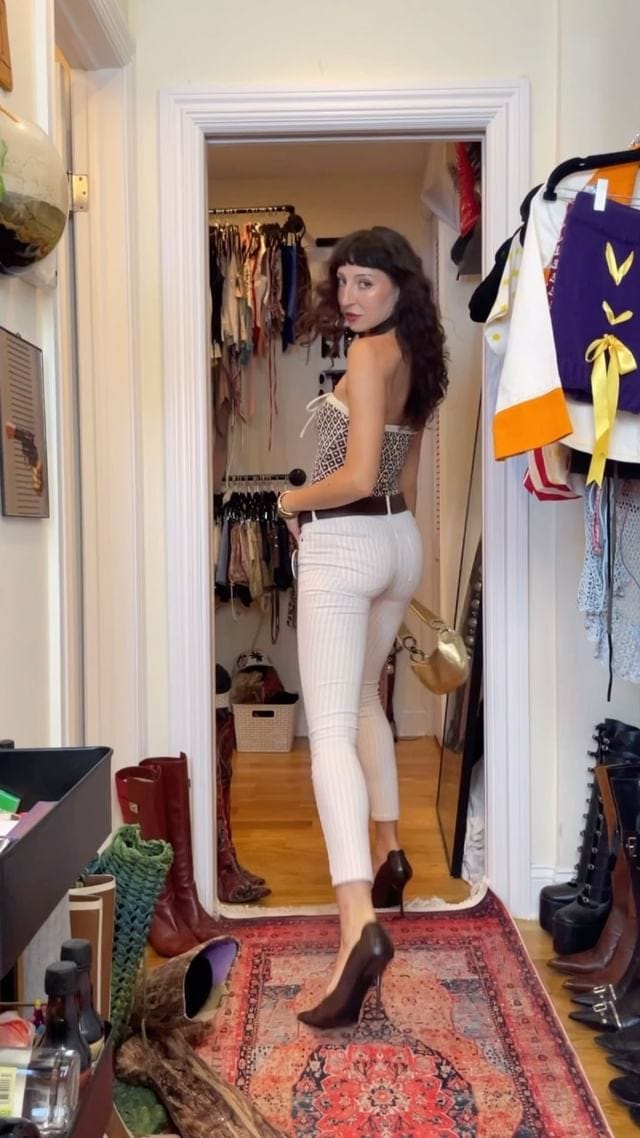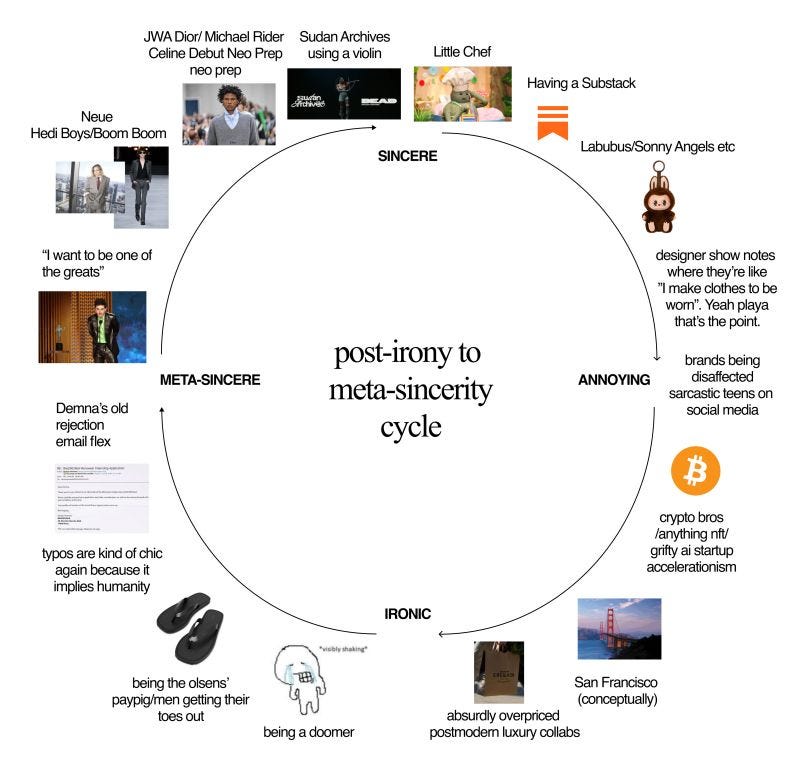Cringe-sincerity cycle
The role of irony in trend revivals
The other day I was walking around Amsterdam (the pijp, specifically) doing my weekly enforced ‘embrace’ of the city I spend so much rent to live in. [In the rush of the week between days at the office, running from one social engagement or another, writing Instagram captions from bed, I often forget to be present where I live.]
Anyways. I came across a girl who was wearing: low rise skinny jeans, a grommeted brown belt, a brown babydoll top, nearly destroyed balenciaga city (inspired) bag, and ballet flats. While a few years ago, one may have flagged this outfit as severely ““behind”” (double quotes bc I am sorry for saying this — but we all do this, right?) but nevertheless, she looked *so* cool.
I couldn’t help but wonder if she:
Was severely behind? (if so, respect for not giving af)
Stepped out of a 2012 time capsule?
Wearing this as a joke/cosplay?
Was really into 2010s revival tiktok?
Her styling indicated the latter, but it did make me think for a second if she was wearing this outfit from the first iteration of these trends in the 2010s, or the second (more recent) iteration of these trends.
“Girl discovers the trend cycle wow” yes BUT how is it possible that trends come back before they are barely forgotten? And what sort of meta-irony mental gymnastics does someone go through to start wearing a trend that seemingly *just* went out of style?
There are a few examples of this.
The one that smacked me across the face that wasn’t necessarily fashion related (but of course I made it fashion related for a post lol) was seeing horsegiirl in Berlin in 2022. Here I was, semi-traumatised by the boys in university saying that horse girls are crazy and that they like big d*cks (enforcing that the worst thing you could be in 2018 was a girl who liked horses) but nevertheless, here was a cool dj at a cool event playing cool music to cool people — called horsegiirl.
A better, clearer, and faster example of this is skinny jeans:
Sincerity: It’s 2008 and you beg your mom to take you to the mall so you can buy skinny jeans. Your family makes fun of your too-tight jeans.
Saturation: It’s 2016 and your entire friend groups shows up to the pre game in some variation of high-waisted skinny jeans and a crop top.
Cringe: It’s 2020 and anyone who still shows up in a skinny jean (anywhere) clearly isn’t on TikTok consuming Gen-Z versus Millennial warfare content. Jokes are made. Answers to street interviews asking ‘what is the worst trend’ is always skinny jeans.
Irony: Alix Earle releases a skinny jean with Frame (probably more as engagement bait rather than irony), and a slew of nyc fashion influencers are “styling skinny jeans” (spoiler: it’s probably tucked into a boot). Other influencers make fun of this by styling skinny jeans as an actual joke.
Re-introduction of sincerity: A handful of Very Cool Girls styling low-rise skinny jeans in a 2007-indie-sleaze-kate-moss kind of way. Strong overlap with the ‘irony’ phase. (or is it just ironic? or engagement bait? we may never know)
But why have the element of irony at all? Don’t people bring back trends because they *genuinely* like them?
My initial thought was that people were intentionally wearing them for the joke, understanding the risk, with the sole intention of being funny/ironic/provacative (I wore a ‘Jesus saved my life’ tee to high school in a religious small town as a self-proclaimed atheist, just to be an asshole — would I do this with a fully developed frontal cortex? Probably not.) My initial thought was that people wore this trend to be provocative, but as more people adopted it, the mere exposure effect made it increasingly acceptable. Normalising the look through repetition.
However,
made a more compelling explanation for this that I think is especially relevant in the perpetually-online, hyper-visible world that Gen Z inhabits.From her post: the cringe sincerity cycle and building exclusivity through lore:
Irony is already a hallmark of Gen Z’s cultural expression and a coping mechanism honed in the hyper-visibility of the internet. When you’ve grown up always aware that anything you post could become part of a permanent digital footprint, doing something “ironically” offers a kind of social insurance. If it lands poorly, you were never serious. If it catches on, you were ahead of the curve. This ironic testing ground could become a crucial incubator for trends, especially at a time when influencers are under fire for looking “too chronically online,” and a full-blown witch hunt is underway for so-called “authentic personal style” (whatever that actually is). As fashion TikTok grows more combative, irony may be the soft launch sincerity needs.
Irony as a mode for trying out new trends is not only reserved for fashion.
also has speculated on how cultural moments outside of fashion move between irony and sincerity (which I was made aware of by a colleague excitedly proclaiming - this guy I follow mentioned your instagram in a linkedin post!!). While I would love to paraphrase, I (again) think that it is best in his own words:When the world’s on fire, we huff the copium through irony, detachment, and nihilism. But eventually the bit isn't funny anymore and suddenly, sincerity in all its cringe, sweaty, hopeful earnestness starts to feel intriguing. Misery loves company, but after a while you also get sick of your friend who won't help themselves. Not only is time a flat circle, my mood is too.
It also applies to travel: as
mentioned in a recent podcast episode, Mykonos is fully in it’s cringe era, but likely will be revisited in a couple of years by some ahead-of-the-curve people in a kind of meta-ironic way once the prices start to go down. After a few cool people spend their summers there, it will be picked up again by more and more people, and the cycle will continue.All of this is to say: whether people wear something ironically to be provocative or as a kind of soft landing for experimenting with new ideas, irony seems to play a role in reviving trends. Especially in today’s faster and faster trend cycle.
I don’t think (all) 2010s trends are coming back because people suddenly love them again (do we really think wedge boots with fast-fashion-looking fringe are objectively beautiful? really?). Instead, they return through irony until they’re styled in enough cool ways, seen in enough places, and eventually, thanks to the mere exposure effect, we start liking them again.
Honestly, if an army of girls in de pijp started wearing skinny jeans and ballet flats, could I be convinced to wear them again? Maybe.








Love this article! Was the start of hating skinny jeans already in 2020?? 😮💨oops!
So good